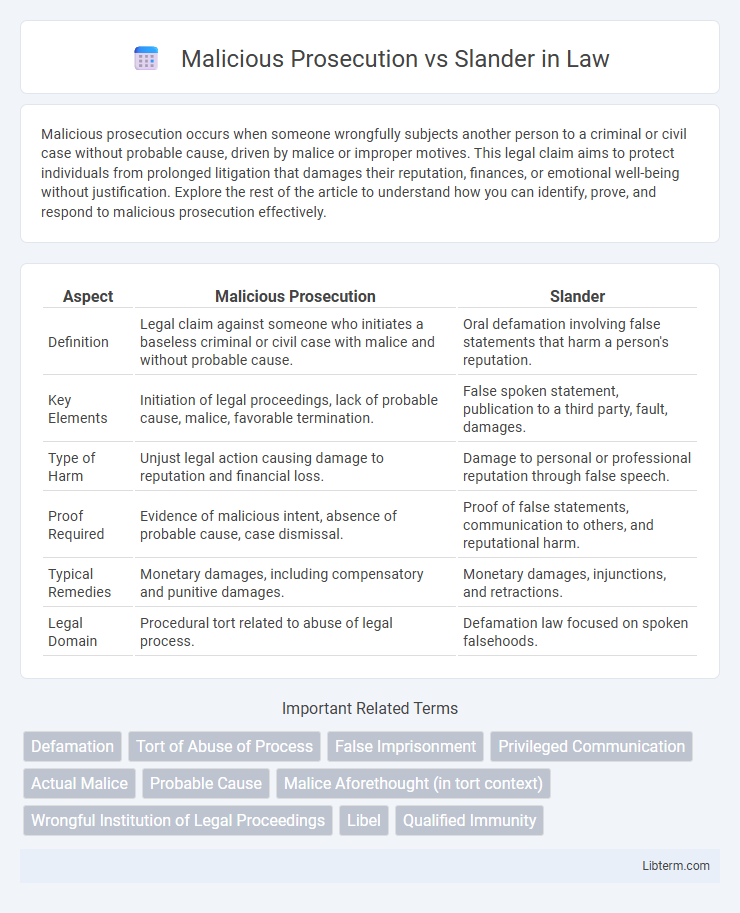Malicious prosecution occurs when someone wrongfully subjects another person to a criminal or civil case without probable cause, driven by malice or improper motives. This legal claim aims to protect individuals from prolonged litigation that damages their reputation, finances, or emotional well-being without justification. Explore the rest of the article to understand how you can identify, prove, and respond to malicious prosecution effectively.
Table of Comparison
| Aspect | Malicious Prosecution | Slander |
|---|---|---|
| Definition | Legal claim against someone who initiates a baseless criminal or civil case with malice and without probable cause. | Oral defamation involving false statements that harm a person's reputation. |
| Key Elements | Initiation of legal proceedings, lack of probable cause, malice, favorable termination. | False spoken statement, publication to a third party, fault, damages. |
| Type of Harm | Unjust legal action causing damage to reputation and financial loss. | Damage to personal or professional reputation through false speech. |
| Proof Required | Evidence of malicious intent, absence of probable cause, case dismissal. | Proof of false statements, communication to others, and reputational harm. |
| Typical Remedies | Monetary damages, including compensatory and punitive damages. | Monetary damages, injunctions, and retractions. |
| Legal Domain | Procedural tort related to abuse of legal process. | Defamation law focused on spoken falsehoods. |
Introduction to Malicious Prosecution and Slander
Malicious prosecution involves initiating a baseless lawsuit with intent to harm the defendant, requiring proof of lack of probable cause and malicious intent. Slander refers to the spoken defamation of a person's character, causing reputational damage through false statements. Both legal concepts protect individuals from unjust harm but apply to different forms of wrongful conduct--legal actions versus verbal statements.
Defining Malicious Prosecution
Malicious prosecution refers to the wrongful initiation of legal proceedings without probable cause and with malice, aiming to harass or wrong the defendant. This tort requires proving that the original case ended in favor of the accused, that the plaintiff lacked reasonable grounds, and that the motive was malicious. In contrast, slander involves making false spoken statements that damage a person's reputation but does not require prior litigation.
Understanding Slander: Key Elements
Slander involves making false and defamatory spoken statements about someone, damaging their reputation. Key elements include the statement being untrue, communicated to a third party, and causing harm or injury to the subject's reputation. Unlike malicious prosecution, slander centers on verbal defamation without the necessity of legal proceedings.
Legal Differences Between Malicious Prosecution and Slander
Malicious prosecution involves initiating a baseless legal action with malice and without probable cause, seeking damages for wrongful litigation. Slander is a form of defamation characterized by spoken false statements that harm a person's reputation. The primary legal difference lies in malicious prosecution requiring a prior lawsuit and proving wrongful legal process, whereas slander centers on damaging oral falsehoods without the necessity of initiating litigation.
Essential Elements Required for Malicious Prosecution
Malicious prosecution requires proving the termination of the prior case in favor of the plaintiff, lack of probable cause, malice, and damages resulting from the prosecution. Unlike slander, which involves defamatory spoken statements causing reputational harm, malicious prosecution focuses on wrongful legal actions initiated without proper grounds. Establishing these essential elements distinguishes malicious prosecution claims from mere defamation or slander cases.
Proving Slander in Court
Proving slander in court requires clear evidence of a false and defamatory spoken statement made to a third party, causing harm to the plaintiff's reputation. The plaintiff must demonstrate the statement's falsity, the defendant's intent or negligence, and actual damages unless the slander falls under defamation per se categories such as accusations of criminal behavior or professional incompetence. Unlike malicious prosecution, which involves wrongful legal actions, slander centers on spoken defamation without necessarily involving litigation.
Common Defenses Against Malicious Prosecution and Slander
Common defenses against malicious prosecution include proving probable cause for initiating the legal action, demonstrating the absence of malice, and showing that the case was resolved in the defendant's favor. In slander cases, defenses often involve establishing truth as a complete defense, demonstrating that the statement was an opinion rather than a factual claim, or proving privilege, such as statements made during judicial proceedings. Both torts require defendants to refute key elements like malice or falsehood to successfully defend against claims.
Examples and Case Studies
Malicious prosecution involves wrongful legal action, such as filing a baseless lawsuit or criminal charge, exemplified by the landmark case of *Benjamin v. Fraser*, where a plaintiff sued for damages after being unjustly prosecuted for alleged fraud. Slander refers to spoken defamatory statements, illustrated by the infamous *New York Times Co. v. Sullivan* case, which addressed false public accusations harming reputation. Distinguishing between these two, malicious prosecution requires proving a lack of probable cause and malice, whereas slander focuses on defamatory statements causing reputational damage.
Damages and Remedies for Victims
Malicious prosecution addresses wrongful legal actions initiated without probable cause, allowing victims to seek damages for harm to reputation, emotional distress, and financial losses arising from the baseless lawsuit. Slander involves the spoken defamation of character, where victims may recover damages for injury to reputation, emotional suffering, and sometimes punitive damages to deter malicious speech. Remedies for malicious prosecution typically include compensatory and sometimes punitive damages, while slander claims emphasize restoring reputation through monetary compensation and, in certain cases, injunctions against further defamatory statements.
Preventive Measures and Legal Advice
To prevent malicious prosecution, individuals should maintain thorough documentation of all communications and evidence related to a legal dispute, ensuring actions are grounded in legitimate grounds to avoid baseless claims. In cases of slander, it is crucial to avoid making unverified defamatory statements and seek prompt retraction or correction to minimize reputational damage. Consulting with an experienced attorney can provide strategic guidance on rights, potential defenses, and the appropriate course of action to reduce liability and protect legal interests.
Malicious Prosecution Infographic

 libterm.com
libterm.com